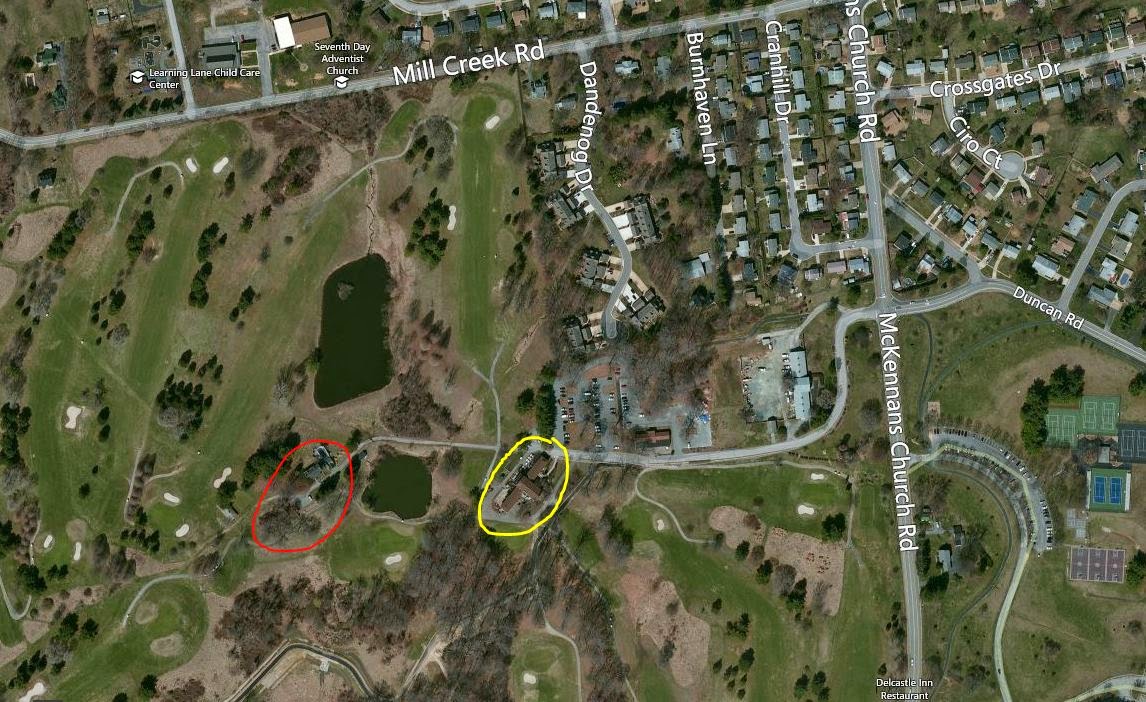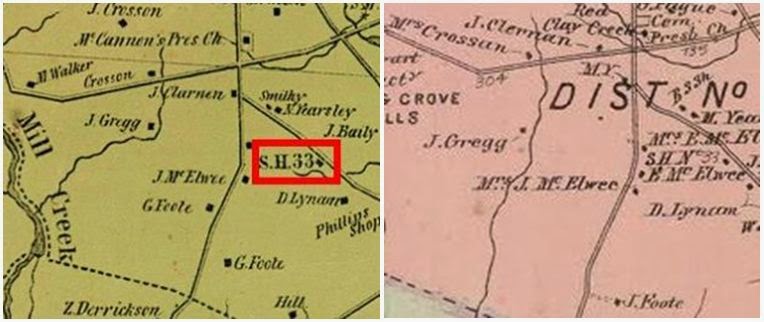 |
| Date stone in the ruins of the Delcastle barn |
In addition to the workhouse farm era buildings, there are a number of other structures dotting the golf course that date to an earlier, and in some cases much earlier, time. I had been aware of some of these for a while (thanks to Mark Julian a few years back), and I've always been interested in the earlier history of the property. Recently, though, I was emailed by Buddy Williamson, who is also curious about the subject, and he even turned me on to a few things I didn't know before. He asked if I knew any more about the older history of the farm and sent me the photo above. Well, funny story.
When he wrote to me, I really didn't know much about the pre-20th Century history of the property. I did some quick research, came up with very little, and even started writing a good bit of a post about it. It was going to be one of those, "I don't know as much as I'd like, here's what I got, I hope someone can come up with some more" kind of posts. Then, one afternoon (after having already written most of the post, mind you), I came across some missing links that made everything fall into place. Now I can confidently say that I know most of the history of this property.
 |
| Gregg House and barn (red) and golf course clubhouse (yellow) |
Sometime around 1800 (probably a couple years after), the farm was purchased by a man named Benjamin Gregg (1771-1835). He was a member of the Gregg family that originally settled in Brandywine Hundred, and his great-grandfather John is thought to have built Strand Millas and possibly Rock Spring. Benjamin and his wife Mary raised ten children on their farm, and both spent the rest of their lives there. The Greggs being Quakers, Benjamin and Mary were both buried at the Hockessin Meeting House. After Benjamin's death, the farm passed to his eldest son, John Gregg (1809-1877). It is John who is the "J. Gregg" shown on both the 1849 and 1868 maps.
 |
| John Gregg on the 1849 (left) and 1868 (right) maps |
John resided his entire life on the family farm, along with his wife Sarah Ann (Walker). After John's passing in 1877, the farm was purchased by his son Benjamin (1835-1910). Benjamin Gregg, along wife his wife Elizabeth (Woodward) Gregg, continued for several decades to farm the land on which men now drive and putt. As he got older, though, he turned over operation of the family farm to his son, Joseph Morton Gregg (1868-1933).
Joseph (or Morton, or J. Morton, depending on the document) probably grew up working the farm with his father, and continued to farm into the early 1900's. The 1900 Census still has him listed as a farmer at what must be the farm. For whatever reason, however, J. Morton Gregg did not remain a farmer much longer. In the 1910 Census, he's listed in Faulkland as a miller at a flour mill. My assumption is that this means he operated the Fell's old grist mill along the Red Clay, close to where the spice mill once stood (and where the burned out remains of it probably still stood then). It is possible, though, that he worked at Greenbank instead.
So J. Morton was not living on the family farm by 1910, but exactly who was is one of the few remaining holes in the story. New Castle County seems to have purchased the property about 1915, but I've yet to see from whom. Joseph Morton Gregg might have sold the farm to someone else after his father Benjamin's death in 1910, or he might have held it and sold directly to the county. In either case it passed out of the Gregg family for the first time in over a century. Now to go back and see how it entered the family.
 |
| Close-up of the Delcastle barn date stone |
I had known that the Greggs owned the property for most if not all of the 1800's, but that didn't help with the barn's 1793 date stone, seen in close-up above. From the layout of the initials (H over top H&W), you'd think we'd be looking for someone with a last name starting with H, and first names with H and W. I asked around and looked through the 1800 Census and 1804 tax list for anything that fit, but nothing jumped out at me. Then I ran across this page and the following paragraph about a quarter of the way down:
Benjamin Gregg is a farmer and owns the same farm that was the home of his Grandmother Gregg, who was Mary Wells, a daughter of Harrison and Hannah Wells, and was born 12, 26. 1787. She married Benjamin Gregg, who purchased this farm, and which was their home with their ten children until their death. Benjamin died 2, 13, 1835, Mary died 5, 31, 1869. Their eldest son. John, who married Sarah A. Walker (1834), purchased the farm and it was the home of their four children. After the marriage of their eldest son Benjamin it became his home, and continues to be at this time (1898). although his youngest son, J. Morton Gregg, attends to the farming.Not only did that clear up most of the Gregg's tenure (which I knew most of), but more importantly it provides the previous owner and the link to the Greggs! Benjamin Gregg bought the farm from his father-in-law Harrison Wells, or possibly from mother-in-law Hannah after Harrison's death in 1795. So the initials in the stone are those of H(arrison) & H(annah) W(ells), and Harrison has his own story.
Harrison Wells (1749-1795), sometimes spelled Wills, was born to Noah and Mary (Harrison) Wills, probably in Trenton Township, New Jersey. He married Hannah Van Leer about 1776, and not long after found himself in trouble...quite a bit of it. It seems that with the outbreak of the Revolutionary War, Harrison was convinced (at least that's how it was spun later) to become a Loyalist and side with the British against the Americans. After the British withdrawal from the area in 1778, local Loyalists were arrested and tried for treason, Wells among them.
Sometime later in the year, Wells was convicted of treason and sentenced to death. However, an appeal was made on his behalf and his sentence was reduced to a forfeiture of his property. It's logical to assume that it was after these events that he and Hannah moved to Chester County, in the area of Marple Township and Springfield. In 1786, they purchased from William Williamson the property that would one day become Delcastle. This page has a good bit of information about Wells, including the indenture (mortgage) for the 1786 sale.
There are still a few details yet to be filled in for the pre-prison farm history of the property, including who sold it to the county, a few small holes prior to Wells' ownership (although Walt Chiquoine has it pretty well laid out), and the exact construction date for the house that stands near the ruins of the stone barn. But, I've got to say, this is much more than we (or just about anyone else, as far as I can see) knew about it before. If anything more is uncovered, I'll be sure to pass it on.
Great research and great post. I have a lot of interest in this property and its history. There are still a lot of old buildings on the property. My father, brother and myself walked around the property with the owner a long time ago. At that time there still was a old time walk-in cooler in the basement of the current clubhouse. Thank you for all the research and writing you do on great topics
ReplyDeleteThanks, Mike. Yes, apparently the old wooden walk-in refrigerator doors are still there. Buddy sent me a picture of them, but I wasn't sure about posting it since it's an indoor shot. I've got another short post about a Delcastle mystery coming very soon. I'll be curious to see if you were told anything about them. Stay tuned...
DeleteJust connected the final dots today. William Williamson was married to Margaret Fulton, daughter of Samuel and Barbara Fulton. Samuel died in 1771, Barbara in 1781, and Williamson bought out Margaret's siblings and kept the property intact. Samuel Fulton bought this 180 acres from the Robinson family, as it was part of the Wedgbury tract.
ReplyDeleteBarbara Fulton spent her ten years as a widow on 68 acres that surrounded the house and barn described above. It is possible that the house dates back to the Fulton era.